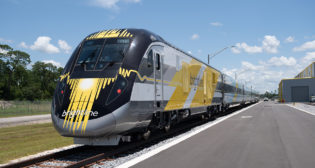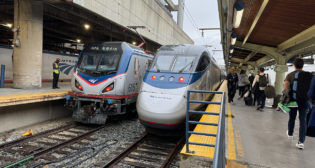
Can Amtrak avoid creative destruction?
Written by Frank N. Wilner, Capitol Hill Contributing EditorWatching Washington, December 2017: Ignore Professor Plum in the library with a candlestick as being responsible for Amtrak inefficiency. Refocus on reform—and clues leading to Amtrak’s new President Richard Anderson, who ideally possesses the determination, means, motive and opportunity to correct decades of fuzzy accounting, impose financial transparency and purge waste.
With all federal programs under political attack, Amtrak, more than ever, must be roused to deliver its services better, faster and cheaper. The Department of Transportation’s Inspector General has long fussed of Amtrak’s “unreliable financial performance reporting.” The U.S. General Accountability Office says Amtrak’s “inconsistent and incomplete” financial reporting “hinders its ability to demonstrate the performance of its lines of business.”
Throughout its near five-decade dependence on the public dole, Amtrak has failed repeatedly to report accurately where its subsidy goes. That Congress enables the charade by writing still more checks on the public purse suggests pitch black rather than light at the tunnel’s end. If something cannot go on forever, it will stop. And when it stops, woe be those unprepared.
Among Anderson’s qualifications to succeed at Amtrak is being a former CEO of global travel providers Delta and Northwest airlines, where price sensitivity, cost containment and consumer satisfaction are immense challenges.
Notably on Anderson’s speed dial is career railroader Wick Moorman, former CEO of efficiency-model Norfolk Southern, who became Amtrak’s transitional president in September 2016, has shared the presidency with Anderson since July, and who becomes an Amtrak adviser Jan. 1. The two already have commenced to reduce a management headcount bloat, consolidate reporting and enhance customer amenities.
Locked in Amtrak’s accounting fog that they are resolved to penetrate is a careless assignment of costs attending lines of business, including long-distance, state-supported and Northeast Corridor routes, as well as infrastructure assets and ancillary services. The “Host Railroad” reports Amtrak publishes still use “metrics and standards” found unconstitutional in 2016. Only with accurate and transparent reporting can Amtrak business-lines managers be held properly accountable.
States that collectively pony-up $250 million annually in subsidies for 29 routes of fewer than 750 miles each—all operated by Amtrak and accounting for 49% of its total ridership—justifiably seek more accurate line-by-line accounting of how that money is assigned. Greater transparency here will permit private-sector operators to compete for those contracts. The first priority of Amtrak’s board and management is protection of the public purse, not the status quo.
The 2008 Passenger Rail Investment and Improvement Act (PRIIA) created a framework for selecting alterative state-supported corridor-route operators, and provided for portability of labor agreements and a Surface Transportation Board arbitration process to settle disputes over asset transfers. Accident liability issues and willingness of freight railroads to allow non-Amtrak operators over their track remain obstacles.
That such hurdles have been eliminated on commuter routes operated by non-Amtrak entities suggest that public-private partnerships on Amtrak long-distance and state-supported routes are feasible.
Moreover, the 2015 Fixing America’s Surface Transportation (FAST) Act authorized a four-year pilot program to open three of Amtrak’s long-distance routes to competition. Only with reliable cost data will qualified entrepreneurs such as Herzog, Keolis and Veolia, which successfully compete with Amtrak for commuter operating contracts, have incentive to bid, as the FAST Act initially limits new operators to 90% of the current subsidy.
Another hurdle is separating Northeast Corridor infrastructure and overhead allocations from long-distance and state-supported routes. One proposal is an infrastructure management organization. AIRNet-21 would manage the NEC under lease, self-finance NEC expansion and renewal, and earn a profit through user charges and commercial development. Separation of infrastructure management from NEC train operation is another competitive opportunity.
If Amtrak doesn’t reform itself, then creative destruction—the economic concept of replacing something less efficient with something more effectual—will accomplish the task.
If financial reform is not now accomplished, then when? If not accomplished by Anderson and Moorman, then by whom? And how else will Amtrak succeed against other public works projects battling for progressively fewer public dollars?



